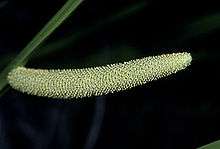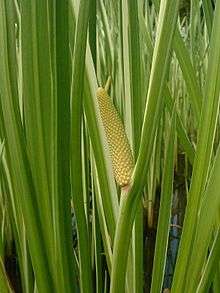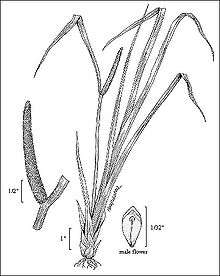Acorus
Acorus is a genus of monocot flowering plants. This genus was once placed within the family Araceae (aroids), but more recent classifications place it in its own family Acoraceae and order Acorales, of which it is the sole genus of the oldest surviving line of monocots. Some older studies indicated that it was placed in a lineage (the order Alismatales), that also includes aroids (Araceae), Tofieldiaceae, and several families of aquatic monocots (e.g., Alismataceae, Posidoniaceae). However, modern phylogenetic studies demonstrate that Acorus is sister to all other monocots. Common names include calamus and sweet flag.
| Acorus | |
|---|---|
 | |
| Sweet flag Acorus calamus - spadix | |
| Scientific classification | |
| Kingdom: | Plantae |
| Clade: | Tracheophytes |
| Clade: | Angiosperms |
| Clade: | Monocots |
| Order: | Acorales Reveal[1] |
| Family: | Acoraceae Martinov[1] |
| Genus: | Acorus L. |
| Synonyms | |
|
Calamus Garsault [2] | |
The genus is native to North America and northern and eastern Asia, and naturalised in southern Asia and Europe from ancient cultivation.[2][3][4][5][6][7] The known wild populations are diploid except for some tetraploids in eastern Asia, while the cultivated plants are sterile triploids, probably of hybrid origin between the diploid and tetraploid forms.
Characteristics

The inconspicuous flowers are arranged on a lateral spadix (a thickened, fleshy axis). Unlike aroids, there is no spathe (large bract, enclosing the spadix). The spadix is 4–10 cm long and is enclosed by the foliage. The bract can be ten times longer than the spadix. The leaves are linear with entire margin.
Taxonomy
Although the family Acoraceae was originally described in 1820, since then Acorus has traditionally been included in Araceae in most classification systems, as in the Cronquist system. The family has recently been resurrected as molecular systematic studies have shown that Acorus is not closely related to Araceae or any other monocot family, leading plant systematists to place the genus and family in its own order. This placement currently lacks support from traditional plant morphology studies, and some taxonomists still place it as a subfamily of Araceae, in the order Alismatales. The APG III system recognizes order Acorales, distinct from the Alismatales, and as the sister group to all other monocots. This relationship is confirmed by more recent phylogenetic studies.[8][9] Treatment in the APG IV system is unchanged from APG III.[10]
Species
In older literature and on many websites, there is still much confusion, with the name Acorus calamus equally but wrongfully applied to Acorus americanus (formerly Acorus calamus var. americanus).
As of July 2014, the Kew Checklist accepts only 2 species, one of which has three accepted varieties:[2]
- Acorus calamus L. – Common sweet flag; sterile triploid (3n = 36); probably of cultivated origin. It is native to Europe, temperate India and the Himalayas and southern Asia, widely cultivated and naturalised elsewhere.
- Acorus calamus var. americanus Raf. - Canada, northern United States, Buryatiya region of Russia
- Acorus calamus var. angustatus Besser - Siberia, China, Russian Far East, Japan, Korea, Mongolia, Himalayas, Indian Subcontinent, Indochina, Philippines, Indonesia
- Acorus calamus var. calamus - Siberia, Russian Far east, Mongolia, Manchuria, Korea, Himalayas; naturalized in Europe, North America, Java and New Guinea
- Acorus gramineus Sol. ex Aiton – Japanese sweet flag or grassy-leaved sweet flag; fertile diploid (2n = 18); - China, Himalayas, Japan, Korea, Indochina, Philippines, Primorye
Acorus from Europe, China and Japan have been planted in the United States.
Etymology
The name 'acorus' is derived from the Greek word 'acoron', a name used by Dioscorides, which in turn was derived from 'coreon', meaning 'pupil', because it was used in herbal medicine as a treatment for inflammation of the eye.
Distribution and habitat
These plants are found in wetlands, particularly marshes, where they spread by means of thick rhizomes. Like many other marsh plants, they depend upon aerenchyma to transport oxygen to the rooting zone.[11] They frequently occur on shorelines and floodplains where water levels fluctuate seasonally.
Ecology
The native North American species appears in many ecological studies. Compared to other species of wetland plants, they have relatively high competitive ability.[12] Although many marsh plants accumulate large banks of buried seeds,[13] seed banks of Acorus may not accumulate in some wetlands owing to low seed production.[14] The seeds appear to be adapted to germinate in clearings; after a period of cold storage, the seeds will germinate after seven days of light with fluctuating temperature, and somewhat longer under constant temperature.[15] A comparative study of its life history traits classified it as a "tussock interstitial", that is, a species that has a dense growth form and tends to occupy gaps in marsh vegetation, not unlike Iris versicolor.[16]
Toxicity

Products derived from Acorus calamus were banned in 1968 as food additives by the United States Food and Drug Administration.[17] The questionable chemical derived from the plant was β-asarone. Confusion exists whether all strains of A. calamus contain this substance.
Four varieties of A. calamus strains exist in nature: diploid, triploid, tetraploid and hexaploid.[18] Diploids do not produce the carcinogenic β-asarone. Diploids are known to grow naturally in Eastern Asia (Mongolia and C Siberia) and North America. The triploid cytotype probably originated in the Himalayan region, as a hybrid between the diploid and tetraploid cytotypes.[19] The North American Calamus is known as Acorus calamus var. americanus or more recently as simply Acorus americanus. Like the diploid strains of A. calamus in parts of the Himalayas, Mongolia, and C Siberia, the North American diploid strain does not contain the carcinogenic β-asarone.[20][21][22] Research has consistently demonstrated that "β-asarone was not detectable in the North American spontaneous diploid Acorus [Calamus var. Americanus]".[23]
Uses
The parallel-veined leaves of some species contain ethereal oils that give a sweet scent when dried. Fine-cut leaves used to be strewn across the floor in the Middle Ages, both for the scent, and for presumed efficacy against pests.
References
- Reveal, James L. (17 February 2011). "Indices Nominum Supragenericorum Plantarum Vascularium – S, Solanales". Indices Nominum Supragenericorum Plantarum Vascularium Alphabetical Listing by Genera of Validly Published Suprageneric Names. University of Maryland and Cornell University.
- Kew World Checklist of Selected Plant Families
- Flora of North America: Acorus
- Flora of China, Vol. 23 Page 1, 菖蒲属 chang pu shu, Acorus Linnaeus, Sp. Pl. 1: 324. 1753.
- Govaerts, R. & Frodin, D.G. (2002). World Checklist and Bibliography of Araceae (and Acoraceae): 1–560. The Board of Trustees of the Royal Botanic Gardens, Kew.
- Boyce, P.C., Sookchaloem, D., Hetterscheid, W.L.A., Gusman, G., Jacobsen, N., Idei, T. & Nguyen, V.D. (2012). Flora of Thailand 11(2): 101–325. The Forest Herbarium, National Park, Wildlife and Plant Conservation Department, Bangkok.
- Nooteboom, H.P. (ed.) (2011). Flora Malesiana 20: 1–61. Noordhoff-Kolff N.V., Djakarta.
- Soltis et al 2011.
- Givnish et al 2010.
- Angiosperm Phylogeny Group (2016). "An update of the Angiosperm Phylogeny Group classification for the orders and families of flowering plants: APG IV". Botanical Journal of the Linnean Society. 181 (1): 1–20. doi:10.1111/boj.12385.
- Keddy, P.A. 2010. Wetland Ecology: Principles and Conservation (2nd edition). Cambridge University Press, Cambridge, UK. Chapter 1.
- Gaudet, C.L.; Keddy, P.A. (1988). "Predicting competitive ability from plant traits: a comparative approach". Nature. 334 (6179): 242–243. doi:10.1038/334242a0. Figure 1.
- van der Valk, A. G.; Davis, C. B. (1978). "The role of seed banks in the vegetation dynamics of prairie glacial marshes". Ecology. 59 (2): 322–35. doi:10.2307/1936377. JSTOR 1936377.
- Leck, Mary Allessio; Simpson, Robert L. (1995). "Ten-year seed bank and vegetation dynamics of a tidal freshwater marsh" (PDF). American Journal of Botany. 82 (12): 1547–1557. doi:10.2307/2446183. hdl:2027.42/141113. JSTOR 2446183.
- Shipley, B.; Keddy, P.A.; Moore, D.R.J.; Lemky, K. (1990). "Regeneration and establishment strategies of emergent macrophytes". Journal of Ecology. 77 (4): 1093–1110. doi:10.2307/2260825. JSTOR 2260825. Appendix 3.
- Boutin, C.; Keddy, P. A. (1993). "A functional classification of wetland plants". Journal of Vegetation Science. 4 (5): 591–600. doi:10.2307/3236124. JSTOR 3236124. Figure 2
- "Code of Federal regulations, title 21".
- Ginwal, HS, An efficient genomic DNA isolation protocol for RAPD and SSR analysis in Acorus calamus L.
- Evstatieva et al., Fitologiya 48: 19–22. 1996; Löve & Löve, Proc. Genet. Soc. Canada 2: 14–17. 1957
- Marongiu, L.B; Piras, A; Porcedda, S (2005). "Chemical composition of the essential oil and supercritical CO2 extract of Commiphora myrrha (Nees) Engl. and of Acorus calamus". Journal of Agricultural and Food Chemistry. 53 (20): 7939–43. doi:10.1021/jf051100x. PMID 16190653.
- (Rost and Bos, 1979)
- Antimicrobial activities of the crude methanol extract of Acorus calamus Linn., S Phongpaichit, N Pujenjob, J. Songklanakarin
- Radušienė, J.; Judžentienė, A.; Pečiulytė, D.; Janulis, V. (2007). "Essential oil composition and antimicrobial assay of Acorus calamus leaves from different wild populations". Plant Genetic Resources. 5: 37–44. doi:10.1017/S1479262107390928.
Bibliography
- Govaerts, R. & Frodin, D.G. (2002). World Checklist and Bibliography of Araceae and Acoraceae. 1-560. The Board of Trustees of the Royal Botanic Gardens, Kew.
- Flora of North America: Acoraceae
- Acorales in Stevens, P. F. (2001 onwards). Angiosperm Phylogeny Website. Version 7, May 2006.
- NCBI Taxonomy Browser
- Acoraceae in L. Watson and M.J. Dallwitz (1992 onwards) The families of flowering plants: descriptions, illustrations, identification, information retrieval. Version: 27 April 2006. http://delta-intkey.com.
- Taxonomy and distribution of Acorus in Maine
- Platt, Karen. Gold Fever 2004 ISBN 978-0954576417
- Phylogenetic analysis of rbcL sequences identifies Acorus calamus as the primal extant monocotyledon. Duvall 1993
- Duvall, Melvin R.; Clegg, Michael T.; Chase, Mark W.; Clark, W. Dennis; Kress, W. John; Hills, Harold G.; Eguiarte, Luis E.; Smith, James F.; Gaut, Brandon S.; Zimmer, Elizabeth A.; Learn, Gerald H. (1 January 1993). "Phylogenetic Hypotheses for the Monocotyledons Constructed from rbcL Sequence Data". Annals of the Missouri Botanical Garden. 80 (3): 607–619. doi:10.2307/2399849. JSTOR 2399849.
- Analysis of Acorus calamus Chloroplast Genome and Its Phylogenetic Implications Vadim V. Goremykin 2005
- Givnish, Thomas J.; Ames, Mercedes; McNeal, Joel R.; McKain, Michael R.; Steele, P. Roxanne; dePamphilis, Claude W.; Graham, Sean W.; Pires, J. Chris; Stevenson, Dennis W.; Zomlefer, Wendy B.; Briggs, Barbara G.; Duvall, Melvin R.; Moore, Michael J.; Heaney, J. Michael; Soltis, Douglas E.; Soltis, Pamela S.; Thiele, Kevin; Leebens-Mack, James H. (27 December 2010). "Assembling the Tree of the Monocotyledons: Plastome Sequence Phylogeny and Evolution of Poales". Annals of the Missouri Botanical Garden. 97 (4): 584–616. doi:10.3417/2010023.
- Soltis, D. E.; Smith, S. A.; Cellinese, N.; Wurdack, K. J.; Tank, D. C.; Brockington, S. F.; Refulio-Rodriguez, N. F.; Walker, J. B.; Moore, M. J.; Carlsward, B. S.; Bell, C. D.; Latvis, M.; Crawley, S.; Black, C.; Diouf, D.; Xi, Z.; Rushworth, C. A.; Gitzendanner, M. A.; Sytsma, K. J.; Qiu, Y.-L.; Hilu, K. W.; Davis, C. C.; Sanderson, M. J.; Beaman, R. S.; Olmstead, R. G.; Judd, W. S.; Donoghue, M. J.; Soltis, P. S. (8 April 2011). "Angiosperm phylogeny: 17 genes, 640 taxa". American Journal of Botany. 98 (4): 704–730. doi:10.3732/ajb.1000404. PMID 21613169.
| Wikisource has the text of the 1905 New International Encyclopedia article Acorus. |
